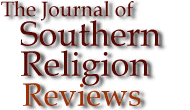

Stephen A. Marini. Sacred Song in America: Religion, Music, and Public Culture. Urbana and Chicago: University of Illinois Press, 2003. Reviewed by James R. Goff, Jr., for the Journal of Southern Religion.
|
|
|
| ". . . Marini balances an academic and, in places, an almost encyclopedic explanation of the uniqueness and value of each sacred music tradition with a highly personal explanation garnered from his own interaction with individuals representative of the current state of that music in modern America." | |
|
|
Stephen Marini's Sacred Song in America is an attempt to understand the importance and relevance of religious music in the nation. Few historians have ventured into this important area of America's religious culture and, as a result, Marini's sprawling work provokes as many questions as it answers. The first part of the book focuses on five very different traditions of American sacred music: the song and dance rituals of American Indian tribes, sacred song customs of the Hispanic Southwest, the rural white tradition of Sacred Harp singing, the African roots of black church music, and the revival of Jewish klezmer and Sephardic song. The author urges the reader to contemplate the significance of ritual in preserving a community's unique heritage, the ironic mixture of traditional rural performers with urban newcomers seeking an older and purer style of music, and the transfer of Old World conceptions of spirit possession combined with American evangelical theology. In each of these cases, Marini discusses the search for "intense personal engagement with a mythic past" (p. 323).
In the second half of Sacred Song, Marini investigates specific examples of music's role in contemporary American religious circles. Continuing an emphasis on religious diversity, he examines the role of music in the New Age community, the acceptance of the Mormon Tabernacle Choir as an American treasure, controversies over gender language changes in Protestant denominational hymnals, praise music in the Catholic Charismatic Renewal, the dynamic of personal spirituality in the upper class conservatory tradition, and the dilemma of mixing entertainment and worship in the gospel music marketplace. In each case, Marini balances an academic and, in places, an almost encyclopedic explanation of the uniqueness and value of each sacred music tradition with a highly personal explanation garnered from his own interaction with individuals representative of the current state of that music in modern America. The result is a delightful mix of solid historical research and journalistic inquiry.
The breadth of Marini's study is staggering. He treats readers to a hodgepodge of American sacred music and draws the conclusion that, in each case, music serves as a cornerstone for carrying traditions forward and instilling practical religious values. Especially impressive is the interdisciplinary and comparative qualities of the study. Among other pertinent themes, readers will find in America's sacred music traditions a solid core of theological presuppositions, a mainstay of class and ethnic identity, the challenges and perils of economic motivation, and a multitude of debates over social and cultural change. Marini's solid contribution to the all-too-sparse number of works that recognize the rich contribution of American sacred music promises to spur a number of academic studies and thereby enrich the future historiography and understanding of American culture.
James R. Goff, Jr., Appalachian State University
© 1998-2003 by The Journal of Southern Religion. All rights reserved. ISSN 1094-5234